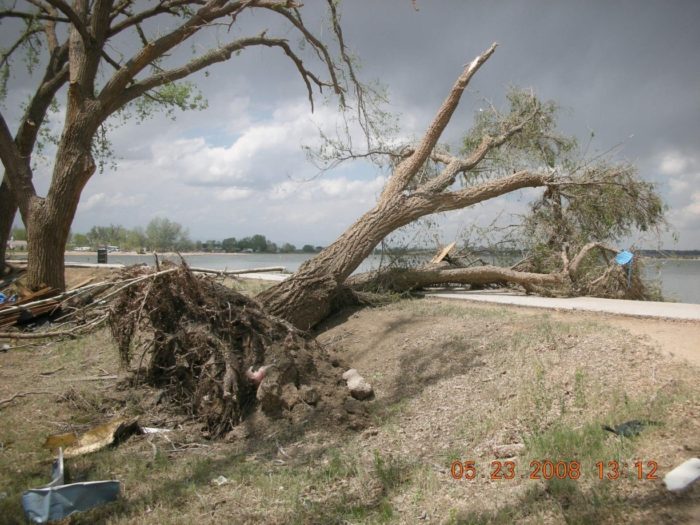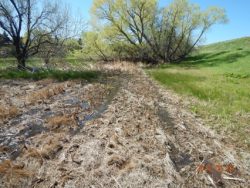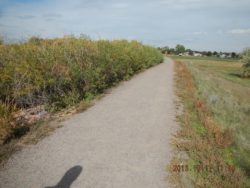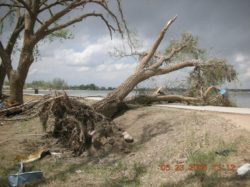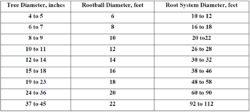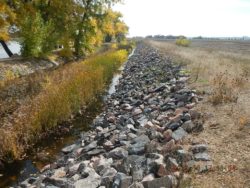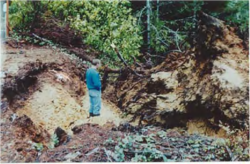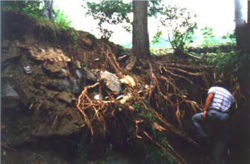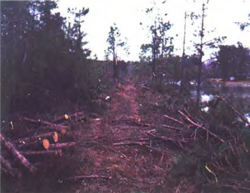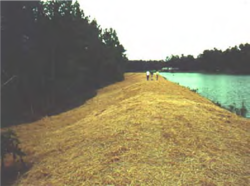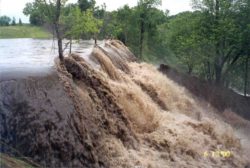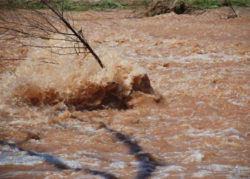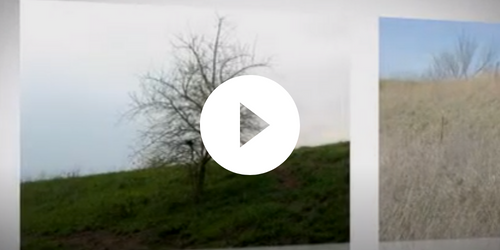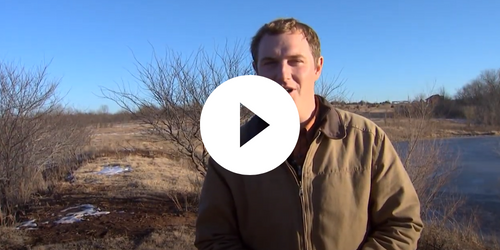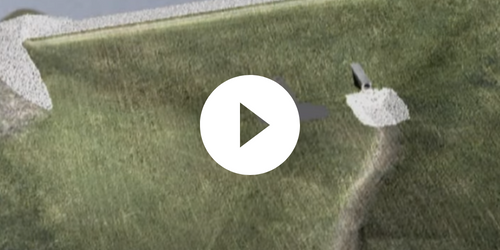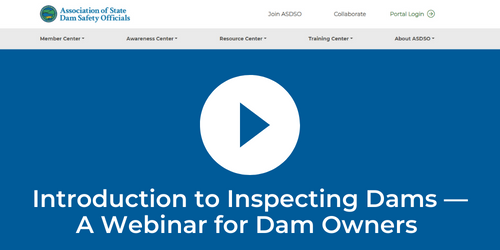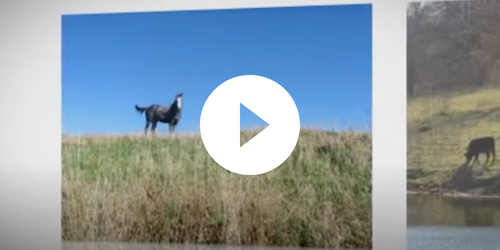Description & Background
Vegetation proliferates at earthen dam sites as they are made of compacted soil and are typically in close proximity to a water source. Vegetation also develops on both concrete and earthen dam abutments. Some types of vegetation are beneficial, while others are detrimental. Relative to the number of trees known to exist on dams and a review of past dam failure case studies, it is generally uncommon for woody vegetation alone to cause dam failure; however, numerous dam failure case histories identify woody vegetation as a contributing factor in the dam failure process. For this reason, it is important to eliminate woody vegetation on and around dams and levees to minimize the potential for internal erosion and structural damage while maintaining beneficial grassy vegetation to reduce the potential for surface erosion.
Trees and brush growing on embankments and abutments can physically impede inspection access, prevent thorough observation and assessment of engineered fill, clog drainage systems, and mask underlying concerns in the structure of the dam. Dense brush also creates ideal habitats for burrowing animals and masks damage they cause that can negatively alter the stability and integrity of the dam. Therefore, vegetation on and around a dam that impedes visual and physical inspection should be removed to ensure the most reliable inspection possible.
Fallen trees and brush pose significant concerns on and around dams as they can inhibit the hydraulic efficiency of the appurtenances, cause damage to the dam, and destabilize slopes. Strong winds can uproot large trees, creating large loose voids in the slope and decreasing the length of seepage paths through the dam. Depending where they fall, the uprooted vegetation can reduce freeboard, decrease the capacity of the spillway, decrease the width of the dam, and potentially damage the dam or its appurtenances. It is important to be vigilant and monitor existing vegetation for signs of decay and remove dead vegetation before problems arise.
Woody vegetation tends to facilitate surface erosion. Woody vegetation in grass-lined spillways creates focal points for erosion initiation due to the creation of flow concentration and increased turbulence. For the same reason, woody vegetation on downstream slopes can initiate and hasten erosion progression if the dam is overtopped during flood conditions. Tree and brush canopies can hinder the establishment of beneficial grass cover while the roots of the plants tend to loosen compacted soils. Large trees can overburden embankments with their weight, which can contribute to slope creep and slope failures. Together, these problems increase the susceptibility of the soil to external erosion from rainfall or snowmelt. Woody vegetation also creates focal points for erosion when located in grass-lined spillways and other areas where surface water flow is anticipated. A dense, uniform grass cover is the ideal vegetation on a dam, as the depth of grass root penetration is minimal and the surficial compacted soils of an embankment will typically uphold the shallow grass root penetration. Grass should be mowed prior to inspections, allowing for better observation while still providing protection against external erosion.
Trees and woody vegetation can also facilitate internal erosion. Roots of live plants will seek any readily available water source, commonly through the dam towards the reservoir. Roots can clog and cause damage to seepage collection systems while short circuiting seepage filters. Decaying roots create preferential seepage paths through a dam that require mitigation measures and can lead to dam failure if left unaddressed. Internal erosion is not as outwardly evident and generally is not discovered until there is an issue, whether minor or catastrophic. Minor issues can usually be corrected when detected at an early stage of development, although these corrections often take time and money to analyze and develop an appropriate repair plan. Major issues lead to emergency situations up to failure of the dam. The remediation for such is expensive and time consuming, in some cases requiring complete removal and reconstruction of the dam.
The Association of State Dam Safety Officials (ASDSO) sent out survey questionnaires to dam safety officials in all 50 states and to federal representatives of the Interagency Committee on Dam Safety (ICODS) to determine state and federal agency attitudes about the effects of trees and woody plant growth on dams under their jurisdiction (ASDSO, 1999). Of the 48 states that responded, all state dam safety officials indicated that they consider trees and plant growth on dams to be a safety problem.
While half the states report having only 20 percent or fewer dams with significant trees and woody vegetation that hinder inspections, vegetation on an estimated 30,000 or nearly a third of the collective state-regulated dams, is reported to obstruct effective dam safety inspections.
Twenty-four of the 48 responding states noted that they had formal policies and/or operating procedures for addressing tree and woody plant growth issues. Of the remaining 24 states indicating that they have no formal policies or procedures, the range of recommended procedures to dam owners varies widely. Some states evaluate dams on a case-by-case basis, while other states require owners either to maintain their dams, to remove vegetation for inspection, or to use other means for dealing with plant problems such as requiring a qualified engineer to be retained, depending on the dam hazard classification (Technical Manual for Dam Owners, Impacts of Plants on Earthen Dams, FEMA 534, 2005).
Some recent research has highlighted benefits to woody vegetation on levees. Research by Lammeranner and Meixner (2009) has concluded that the woody vegetation can be beneficial, suggesting that dense woody vegetation provides greater erosion resistance, energy dissipation, and slope stability along the riverside of levee applications. They further argue that the voids created by decaying roots are backfilled by roots from adjacent living trees. Although these studies appear to contradict concerns discussed earlier, levee owners must carefully weigh the importance of leaving a tree on an embankment versus the potential consequences that could result from failure of the embankment, including property damage and potential life loss. While it is reasonable to anticipate some benefit will be realized by allowing woody vegetation to remain, it only takes one weak link to initiate failure.
It is also important to consider the function of the embankment. Adverse effects created by woody vegetation tend to be more apparent on active storage dams because they generally impound water on a permanent basis whereas levees and flood control dams are typically only loaded for a relatively short period of time during flood conditions. The permanent reservoir loading at active storage dams creates a much higher likelihood that adverse consequences might occur. At the same time, the sudden loading of levees and flood control dams during flood conditions can lead to the rapid development of adverse conditions of which the owner was previously unaware, leading to emergency actions at a time when emergency response agencies are generally already stressed. For these reasons, dam and levee owners should strive to eliminate woody vegetation on and near dams and levees. Only after careful consideration and consultation with dam and levee safety experts should they consider allowing any woody vegetation to remain.
In conclusion, state and federal dam safety officials and industry experts generally agree that trees and woody vegetation should be eliminated from all water impounding structures. The safety and stability of dams and levees depend on the integrity of the embankments and abutments to withstand the hydraulic loads from the water in reservoirs and rivers. Evidence has demonstrated that woody vegetation is responsible for compromising the integrity of dams and levees, therefore prompt removal of existing woody vegetation on and near dams and levees, and maintenance of uniform dense grass cover on earthen surfaces, is recommended. If woody vegetation exists on or around a dam or levee, the owner should consult with their engineer and coordinate with their state dam safety official to determine an appropriate vegetation control plan, as policies differ from state to state. Proper maintenance and monitoring of appropriate vegetation around dams and levees will reduce dam failure risk factors and prolong the life of the structure.
References:
(6) VA DCR. Vegetation, erosion and dams. Virginia Department of Conservation and Recreation.
(7) Lammeranner, W. & Meixner, H. (2009). Woody plants on flood protection levees: A contradiction?
This lesson learned was peer-reviewed by Gregory Richards, P.E., Gannett Fleming, Inc.
Summary
Photos
- Active seepage flowing from the base of a tree cluster at the toe of a dam (Photo source: the Colorado Department of Water Resources).
- Example of inspection-hindering woody vegetation on the upstream slope of a dam (Photo source: the Colorado Department of Water Resources).
- Embankment damage caused by downed tree (Photo source: the Colorado Department of Water Resources).
- Typical Rootball and Root System Sizes for Various Tree Sizes (Photo source: FEMA 534 – Technical Manual for Dam Owners, Impacts of Plants on Earthen Dams).
- Example where setback dam (right) was constructed immediately downstream of original dam (left) because setback dam was more cost effective than remediating concerns due to vegetation growth on the original dam (Photo source: the Colorado Department of Water Resources).
- Serious damage by uprooted tree to embankment dam in Oregon (Photo source: FEMA 534 – Technical Manual for Dam Owners, Impacts of Plants on Earthen Dams).
- Tree root induced scouring on crest and downstream face of Coffey Dam in Kansas (Photo source: FEMA 534 – Technical Manual for Dam Owners, Impacts of Plants on Earthen Dams).
- Trees cut prior to removing stumps and roots from dam (Photo source: FEMA 534 – Technical Manual for Dam Owners, Impacts of Plants on Earthen Dams).
- Completed remediation job after removing stumps, seeding, fertilizing & mulching (Photo source: FEMA 534 – Technical Manual for Dam Owners, Impacts of Plants on Earthen Dams).
- Woody vegetation in flow paths create flow concentrations that exacerbate surface erosion.
- Little Tallapoosa River Watershed Dam No. 19, Carroll County during (left) and after (right) flood conditions in September 2009. Notice extensive erosion where trees created flow concentration versus relatively minor erosion where flow obstructions were not present (Photo source: Georgia NRCS).
- Little Tallapoosa River Watershed Dam No. 20, Carroll County during (left) and after (right) up to 1 foot of dam overtopping flow in September 2009. Lack of erosion on slope despite relatively significant overtopping and high flow velocity credited to uniform cover of dense grassy vegetation (Photo source: Georgia NRCS).
- Flow concentration around small tree in a grass-lined spillway. This condition can accelerate and intensify the erosion process in spillways and on embankments (Photo source: NRCS).
Videos
- Video produced by the Kansas Department of Agriculture describing practices for the maintenance of trees at dams.
- Video produced by Oklahoma State University highlighting the importance of clearing brush from dams.
- Animation of piping failures at dams developed by the Association of State Dam Safety Officials.
- ASDSO Webinar presented by Paul Schweiger highlighting dam inspections and key maintenance issues.
- Video produced by the Kansas Department of Agriculture containing advice on identifying signs of cracking during dam inspections.
Case Studies
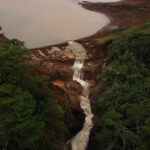
Ka Loko Dam (Hawaii, 2006)
At approximately 5 a.m. on March 14, 2006, following a four-week period of heavy rainfall, Ka Loko Dam experienced an unexpected, catastrophic, and massive breach that quickly drained nearly the entire reservoir.
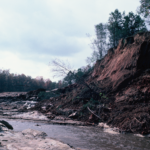
Kelly Barnes Dam (Georgia, 1977)
Kelly Barnes Dam was located approximately a half mile upstream (north) of Toccoa Falls Bible College in Stephens County, Georgia. Toccoa Falls, a 186-foot-high waterfall, was located between the dam and the college. The dam site was originally the location...
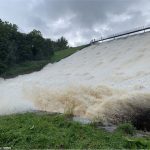
Toddbrook Reservoir Dam (England, 2019)
Toddbrook Reservoir is located just upstream of the town of Whaley Bridge in the High Peak area of Derbyshire, England. The almost 80-foot tall embankment was constructed between 1837 and 1840 for water supply, with a central puddle core and outer shells of more granular earthfill.
Additional Case Studies (Not Yet Developed)
- Unnamed Air Force Academy dam (Colorado, 1999)
- Black Creek Dam (Mississippi, 1983)
- Highland Lake Dam (Maine, 1996)
- Kadashan Bottoms Site 2 Dam (Oklahoma, 2008)
- Nix Lake Dam (Texas, 1989)
- Topsfield Dam (Massachusetts, 1987)
Best Practices
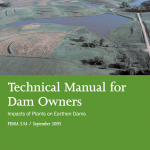
Technical Manual for Dam Owners: Impacts of Plants on Earthen Dams
Author: Federal Emergency Management Agency
Date Published: 2005
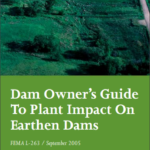
Dam Owner’s Guide to Plant Impact on Earthen Dams
Author: Federal Emergency Management Agency
Date Published: 2005
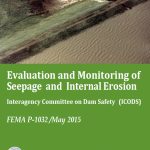
Evaluation and Monitoring of Seepage and Internal Erosion
Author: Interagency Committee on Dam Safety
Date Published: 2015
Other Resources
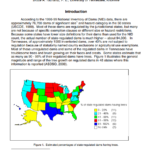
Current Problems, Practices and Policies on Tree and Woody Plant Penetration of Dams
Author: Bruce A. Tschantz, P. E.
ASDSO Conference Paper
Understanding and Managing Plant & Animal Intrusions in Embankment Dams and Levees
Author: Greg Zamensky, P.E.
ASDSO Webinar (On-Demand)
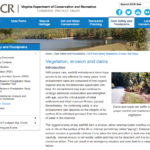
Vegetation, Erosion and Dams
Author: Virginia Department of Conservation and Recreation
Additional Resources Not Available for Download
- Petrocsky, M.B. Highland Lake Dam: Failure, Emergency Repairs And Replacement.
- Purkeypile, D. & Samuelsin, W.D. Historical Dam Failures in Texas.
- Stoner, J.C. & Lobrecht, M.N. (2011). Caught on Tape – The Failure of Kadashan Bottoms Site 2. USDA-NRCS.
- Oakland, M.W. & Gifford, D.G. Economical Renovation of Small Dams.


